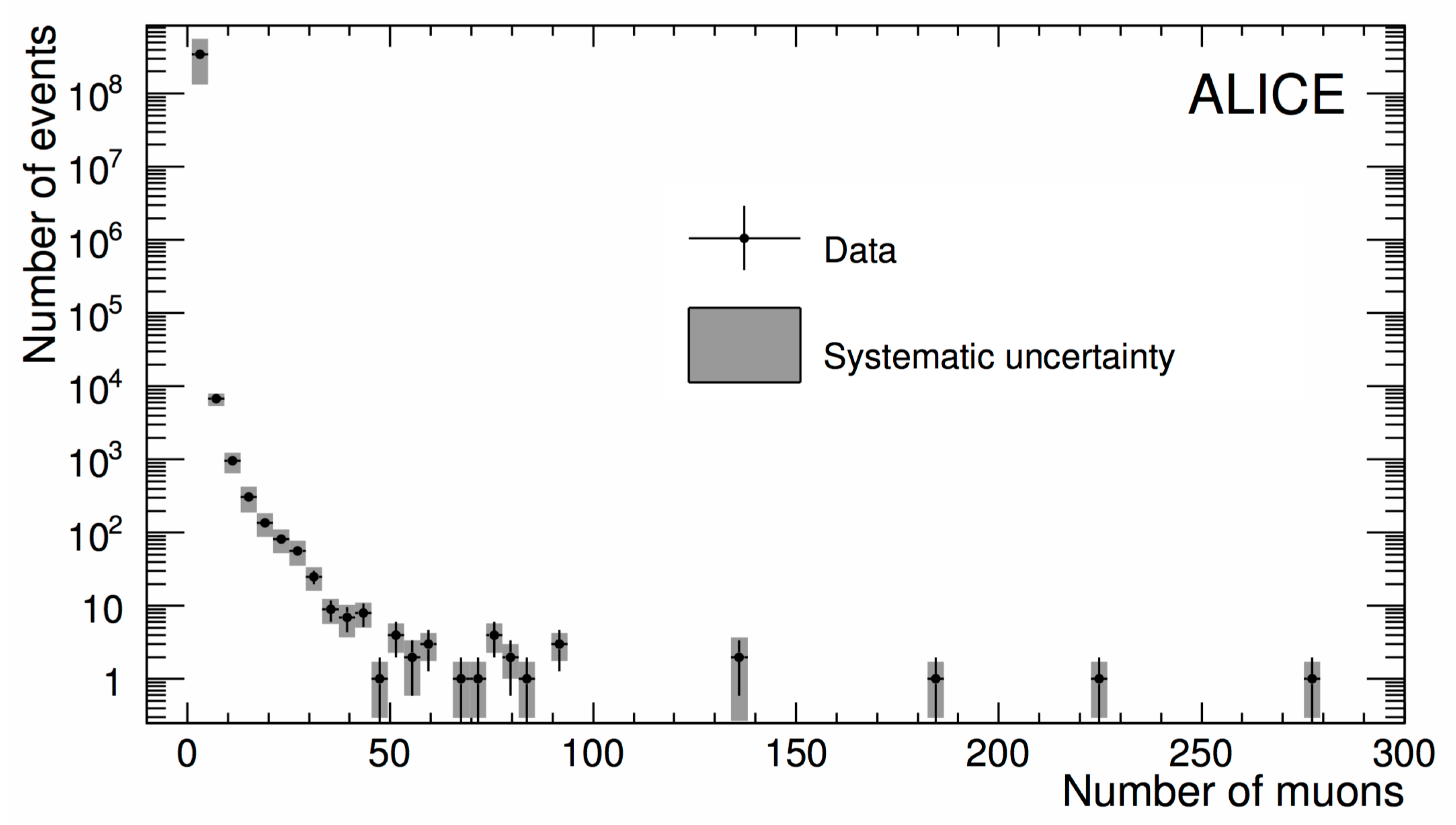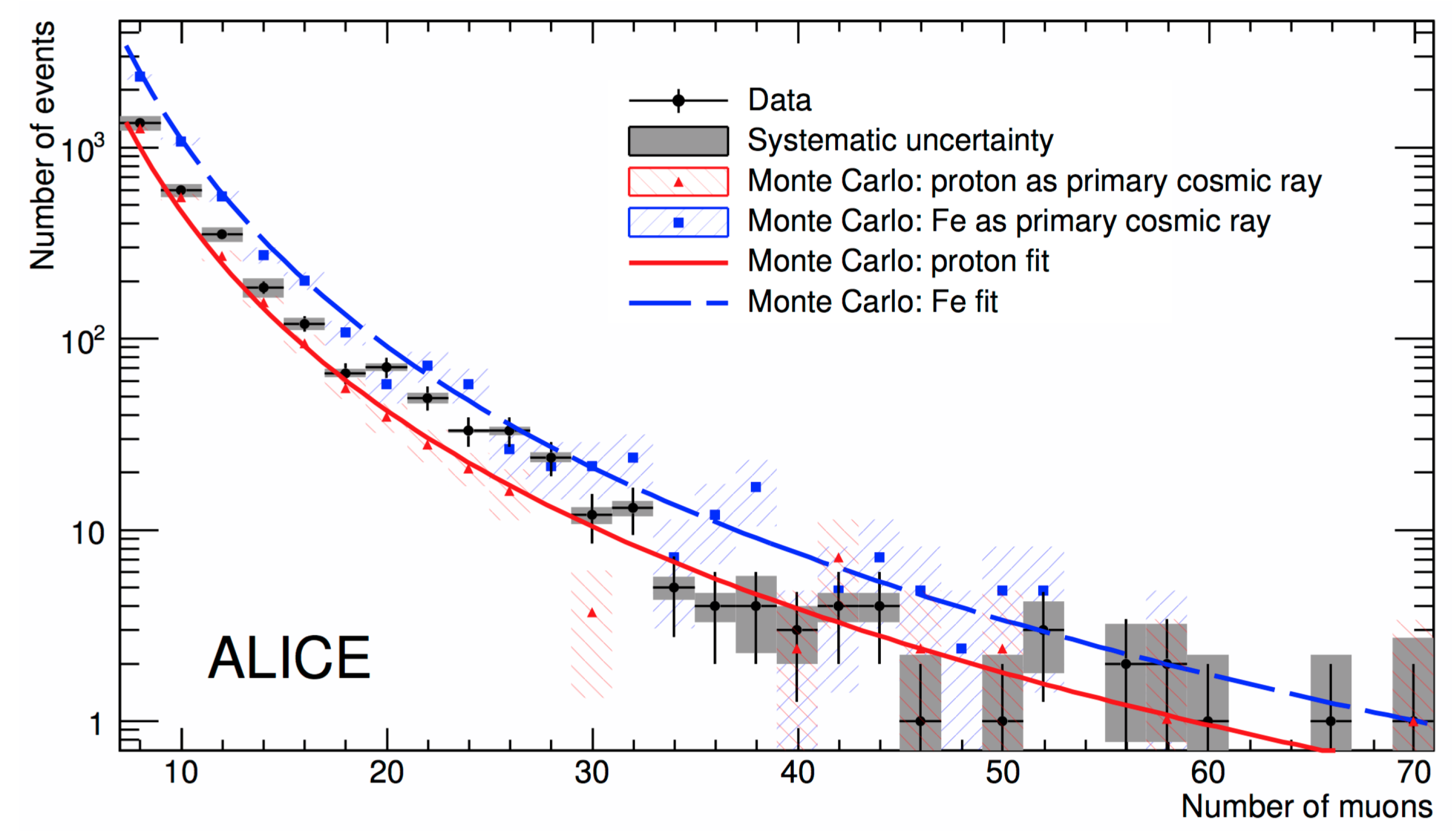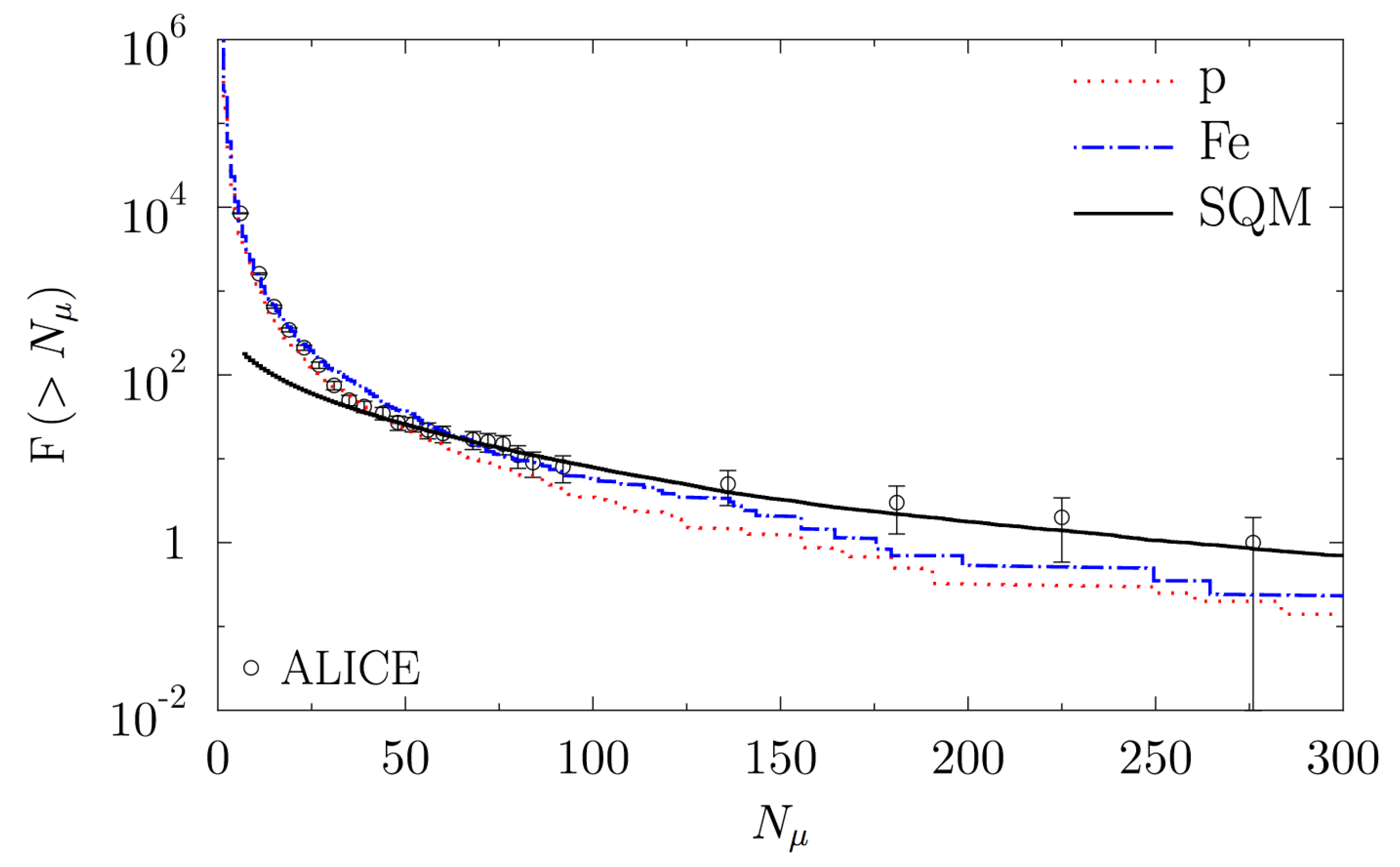Cosmic-Ray Studies with Experimental Apparatus at LHC
Abstract
1. Introduction
Hadron Interaction Models
2. Cosmic Ray Studies with LHC Experiments: ALICE and CMS
Study of Muon-Bundles with ALICE
3. Future Experimental Arrangement: MATHUSLA Proposal
- 1
- STD: It will provide data about the arrival times, individual trajectories and spatial distributions of the charged particles produced along the EAS front at observation level. With this information, MATHUSLA will be able to reconstruct the location of the shower core, the direction of the shower axis, the slope of the radial distribution of particle densities (also known as shower age, s) and the shower size of the EAS. The shower size reveals the energy of the primary cosmic ray, while the shower age is sensitive to the mass of the primary cosmic ray.
- 2
- CB: If MATHUSLA triggers the underground CMS/ATLAS detector in order to measure simultaneously the passage of shower events, then additional EAS information on high energy muons ( for vertical incidence) will be available. Using the capabilities of CMS/ATLAS shower observables like the local number of muons per , the distributions and the ratio per shower event will be also measured. The combined data from the surface and underground detectors about EAS events could improve our analyses of composition of cosmic rays. Besides, coincident measurements of MATHUSLA with the CMS/ATLAS will allow to study the phenomenon of muon bundles in connection with extensive air showers.
3.1. Stand Alone Mode
3.2. Combined Mode
3.3. Comparison with Other EAS Detectors
- Full coverage with robust tracking: That is an advantage from the usage of different layers of fine segmented RPCs, which no other EAS ground-based detector posses. Full coverage was achieved by the ARGO-YBJ detector [61], but since it counted with a single layer of RPCs, it did not count with the tracking capabilities that are expected for MATHUSLA. Other detectors like KASCADE [62] counted with muon tracking (150 ) and calorimeter (16 × 20 ) systems but the coverage was reduced to less than . Besides their area, compared with MATHUSLA, was reduced in size.
- Highly granular measurements of the shower’s temporal and spatial structure: From the list of PeV EAS detectors provided, only ARGO-YBJ [61] and the muon tracking and calorimeter systems of KASCADE [62] were able to perform fine measurements of the temporal/spatial structure of the showers for the charged component of EAS in the former case, and the muon and hadron components in the latter.
- Tandem measurements with a fine muon underground detector: Underground muon tracking detectors have been used before in other air shower facilities, for example, at the KASCADE observatory [62], however they were lacking the capabilities of the ATLAS/CMS detectors, which are also able to measure the charge and spectrum of individual muons. The capabilities of MATHUSLA might be further expanded when working in coincidence mode with the CMS or ATLAS detector. That will complement the EAS measurements of MATHUSLA with detailed information of the muon content at high energies, which will be useful for the study of the spectrum and composition of cosmic rays, and the understanding of high-energy hadronic interactions in the forward region, where there are significant uncertainty calculations. In addition studies of muon bundles might be devised in connection with air showers.
4. Conclusions
Author Contributions
Funding
Conflicts of Interest
References
- Bluemer, J.; Engel, R.; Hoerandel, J.R. Cosmic Rays from the Knee to the Highest Energies. Prog. Part. Nucl. Phys. 2009, 63, 293–338. [Google Scholar] [CrossRef]
- Grenier, I.A.; Black, J.H.; Strong, A.W. The Nine Lives of Cosmic Rays in Galaxies. Annu. Rev. Astron. Astrophys. 2015, 53, 199–246. [Google Scholar] [CrossRef]
- Mollerach, S.; Roulet, E. Progress in high-energy cosmic ray physics. Prog. Part. Nucl. Phys. 2018, 98, 85–118. [Google Scholar] [CrossRef]
- The Pierre Auger Collaboration. Observation of a large-scale anisotropy in the arrival directions of cosmic rays above 8×1018 eV. Science 2017, 357, 1266–1270. [Google Scholar] [CrossRef]
- Giacinti, G.; Kachelrie, M.; Semikoz, D.V. Escape model for Galactic cosmic rays and an early extragalactic transition. Phys. Rev. D 2015, 91, 083009. [Google Scholar] [CrossRef]
- Gaisser, T.K.; Stanev, T.; Tilav, S. Cosmic ray energy spectrum from measurements of air showers. Front. Phys. 2013, 8, 748–758. [Google Scholar] [CrossRef]
- Fermi-LAT Collaboration. Detection of the Characteristic Pion-Decay Signature in Supernova Remnants. Science 2013, 339, 807–811. [Google Scholar] [CrossRef] [PubMed]
- HESS Collaboration. Acceleration of petaelectronvolt protons in the Galactic Centre. Nature 2016, 531, 476–479. [Google Scholar] [CrossRef]
- Fang, K.; Murase, K. Linking high-energy cosmic particles by black-hole jets embedded in large-scale structures. Nat. Phys. 2018, 14, 396–398. [Google Scholar] [CrossRef]
- The Pierre Auger Collaboration. Muons in air showers at the Pierre Auger Observatory: Mean number in highly inclined events. Phys. Rev. D 2019, 91, 032003. [Google Scholar]
- The Pierre Auger Collaboration. Testing Hadronic Interactions at Ultrahigh Energies with Air Showers Measured by the Pierre Auger Observatory. Phys. Rev. Lett. 2016, 117, 192001. [Google Scholar] [CrossRef] [PubMed]
- The Pierre Auger Collaboration. Inferences on Mass Composition and Tests of Hadronic Interactions from 0.3 to 100 EeV using the water-Cherenkov Detectors of the Pierre Auger Observatory. Phys.Rev. D 2017, 96, 122003. [Google Scholar] [CrossRef]
- ICECUBE Collaboration. Neutrino emission from the direction of the blazar TXS 0506+056 prior to the IceCube-170922A alert. Science 2018, 361, 147–151. [Google Scholar] [CrossRef] [PubMed]
- Becker, J.K. High-energy neutrinos in the context of multimessenger physics. Phys. Rep. 2008, 458, 173–246. [Google Scholar] [CrossRef]
- Knoedlseder, J. The future of gamma-ray astronomy. Comptes Rendus Phys. 2016, 17, 663–678. [Google Scholar] [CrossRef]
- CREAM Collaboration. The Cosmic Ray Energetics And Mass (CREAM) instrument. Nucl. Instrum. Methods A 2007, 579, 1034–1053. [Google Scholar] [CrossRef]
- CREAM Collaboration. Discrepant hardening observed in cosmic-ray elemental spectra. Astrophys. J. 2010, 714, L89–L93. [Google Scholar] [CrossRef]
- AMS Collaboration. The Alpha Magnetic Spectrometer on the International Space Station. Int. J. Mod. Phys. E 2012, 21, 1230005. [Google Scholar] [CrossRef]
- AMS Collaboration; Aguilar, M. Precision Measurement of the Proton Flux in Primary Cosmic Rays from Rigidity 1 GV to 1.8 TV with the Alpha Magnetic Spectrometer on the International Space Station. Phys. Rev. Lett. 2015, 114, 171103. [Google Scholar] [CrossRef]
- Kampert, K.; Watson, A.A. Extensive air showers and ultra high-energy cosmic rays: A historical review. Eur. Phys. J. 2012, H37, 359–412. [Google Scholar] [CrossRef]
- Engel, R.; Heck, D.; Pierog, T. Extensive Air Showers and Hadronic Interactions at High Energy. Ann. Rev. Nucl. Part. Sci. 2011, 61, 467–489. [Google Scholar] [CrossRef]
- Gaisser, T.; Engel, R.; Resconi, E. Cosmic Ray and Particle Physics; Cambridge University Press: Cambridge, UK, 1990. [Google Scholar]
- Grupen, C. Astroparticle Physics; Springer: New York, NY, USA, 2005. [Google Scholar]
- Pierog, T. Air Shower Simulations with a New Generation of post-LHC Hadronic Interaction Models in CORSIKA. In Proceedings of the 35th International Cosmic Ray Conference, Busan, Korea, 10–20 July 2017. [Google Scholar]
- Goncalvez, V.; Machado, T. Saturation Physics in Ultra High Energy Cosmic Rays: Heavy Quark Production. J. High Energy Phys. 2007, 4, 28. [Google Scholar] [CrossRef]
- Ayala, A.; Castaño-Yepes, J.D.; Dominguez, C.A.; Hernandez, L.A.; Hernandez-Ortiz, S.; Tejeda-Yeomans, M.E. Prompt photon yield and elliptic flow from gluon fusion induced by magnetic fields in relativistic heavy-ion collision. Phys. Rev. D 2017, 96, 014023, Erratum in Phys. Rev. D 2017, 96, 119901. [Google Scholar] [CrossRef]
- ALICE Collaboration. Coherent J/ψ photoproduction in ultra-peripheral Pb-Pb collisions at = 2.76 TeV. Phys. Lett. B 2013, 718, 1273–1283. [Google Scholar] [CrossRef]
- Matthews, J. A Heitler model of extensive air showers. Astropart. Phys. 2005, 22, 387–397. [Google Scholar] [CrossRef]
- Auger Collaboration. Properties and performance of the prototype instrument for the Pierre Auger Observatory. Nucl. Inst. Meth. Phys. A 2004, 523, 50–95. [Google Scholar] [CrossRef]
- Tunka Collaboration. Tunka-133: Results of 3 year operation. Nucl. Inst. Meth. Phys. A 2014, 756, 94–101. [Google Scholar] [CrossRef]
- TALE Collaboration. The Cosmic-Ray Energy Spectrum between 2 PeV and 2 EeV Observed with the TALE detector in monocular mode. Astrophys. J. 2018, 865, 1–74. [Google Scholar]
- KASKADE Collaboration. The cosmic-ray experiment KASKADE. Nucl. Inst. Meth. Phys. A 2003, 513, 490–510. [Google Scholar] [CrossRef]
- Travnicek, P. Detection of cosmic ray events by LEP experiments. Czech. J. Phys. 2006, 56, A185–A200. [Google Scholar] [CrossRef]
- CMS Collaboration. The CMS experiment at the CERN-LHC. Jinst 2008, 3, S08004. [Google Scholar]
- ALICE Collaboration. The ALICE experiment at the CERN LHC. Jinst 2008, 3, S08002. [Google Scholar]
- The Pierre Auger Collaboration. Direct measurement of the muonic content of extensive air showers between 2×1017 and 2×1018 eV at the Pierre Auger Observatory. Eur. Phys. J. C 2020, 80, 751. [Google Scholar] [CrossRef]
- Anchordoqui, L.A.; Goldberg, H.; Weiler, T.J. Strange fireball as an explanation of the muon excess in Auger data. Phys. Rev. D 2017, 95, 063005. [Google Scholar] [CrossRef]
- Alvarez-Muniz, J.; Cazon, L.; Conceicao, R.; de Deus, J.D.; Pajares, C.; Pimenta, M. Muon production and string percolation effects in cosmic rays atthe highest energies. arXiv 2012, arXiv:1209.6474. [Google Scholar]
- Allen, J.D.; Farrar, G.R. Testing models of new physics with UHE air shower observations. In Proceedings of the 33rd ICRC, Rio de Janeiro, Brazil, 9–12 December 2019. [Google Scholar]
- Avati, V.; Dick, L.; Eggert, K.; Stro¨m, J.; Wachsmuth, H.; Schmeling, S.; Ziegler, T.; Bru¨hl, A.; Grupen, C. Cosmic multi-muon events observed in the underground CERN-LEP tunnel with the ALEPH experiment. Astropart. Phys. 2003, 19, 513–523. [Google Scholar] [CrossRef]
- DELPHI Collaboration. Study of multi-muon bundles in cosmic ray showers detected with the DELPHI detector at LEP. Astropart. Phys. 2007, 28, 273–286. [Google Scholar] [CrossRef]
- Watson, A.A. Conclusions about properties of high-energy cosmic-rays drawn with limited recourse to hadronic models. Nucl. Part. Phys. Proc. 2017, 291–293, 66–73. [Google Scholar] [CrossRef]
- Thomas, K. Gaisser, Spectrum of cosmic-ray nucleons, kaon production, and the atmospheric muon charge ratio. Astrop. Phys. 2012, 35, 801–806. [Google Scholar]
- Rebel, H.; Sima, O. What could we learn from observations of the muon charge ratio in cosmic ray air showers? Rom. Rep. Phys. 2007, 59, 609–624. [Google Scholar]
- CMS Collaboration. Measurement of the charge ratio of atmospheric muons with the CMS detector. Phys. Lett. B 2010, 692, 83–104. [Google Scholar]
- MINOS Collaboration. Measurement of the multiple-muon charge ratio in the MINOS Far Detector. Phys. Rev. D 2016, 93, 052017. [Google Scholar] [CrossRef]
- Ostavchenko, S. Monte Carlo treatment of hadronic interactions in enhanced Pomeron scheme: I. QGSJET-II model. Phys. Rev. D 2011, 83, 014018. [Google Scholar] [CrossRef]
- The TOTEM Collaboration. First measurement of the total proton-proton cross section at the LHC energy of s = 7 TeV. Europhys. Lett. 2011, 96, 21002. [Google Scholar] [CrossRef]
- ALICE Collaboration. Study of cosmic ray events with high muon multiplicity using the ALICE detector at the CERN Large Hadron Collider. JCAP 2016, 1, 32. [Google Scholar]
- Heck, D.; Knapp, J.; Capdevielle, J.N.; Schatz, G.; Thouw, T. CORSIKA: A Monte Carlo Code to Simulate Extensive Air Showers. FZKA-6019. 1998. Available online: https://web.ikp.kit.edu/corsika/physics_description/corsika_phys.pdf (accessed on 13 October 2020).
- Kankiewicz, P.; Rybczynski, M.; Wlodarczyk1, Z.; Wilk, G. Muon Bundles as a Sign of Strangelets from the Universe. Astrophys. J. 2017, 839, 31. [Google Scholar] [CrossRef]
- Ridky, J. Can we observe the Quark Gluon Plasma in Cosmic Ray showers? Astropart. Phys. 2002, 17, 355–365. [Google Scholar] [CrossRef]
- ATLAS Collaboration. The ATLAS Experiment at the CERN Large Hadron Collider. Jinst 2008, 3, S08003. [Google Scholar]
- Curtin, D.; Drewes, M.; McCullough, M.; Meade, P.; Mohapatra, R.N.; Shelton, J.; Shuve, B.; Accomando, E.; Alpigiani, C.; Antusch, C.; et al. Long-Lived Particles at the Energy Frontier: The MATHUSLA Physics Case. Rept. Prog. Phys. 2019, 82, 116201. [Google Scholar] [CrossRef]
- Salam, A.; Strathdee, J. Super-symmetry and non-Abelian gauges. Phys. Lett. B 1974, 51, 353–355. [Google Scholar] [CrossRef]
- Mathusla Collaboration. An Update to the Letter of Intent for MATHUSLA: Search for Long-Lived Particles at the HL-LHC. arXiv 2020, arXiv:2009.01693.
- Stanev, T. High Energy Cosmic Rays, 2nd ed.; Springer: New York, NY, USA, 2004. [Google Scholar]
- Greisen, K. Progress in Cosmic Ray Physics; JG Wilson: Amsterdam, The Netherlands, 1958. [Google Scholar]
- Tapia, A.; Melo, D.; Sánchez, F.; Sedoski Croce, A.; Etchegoyen, A.; Figueira, J.M.; Gamarra, R.F.; García, B.; González, N.; Josebachuili, M.; et al. The lateral shower age parameter as an estimator of chemical composition. arXiv 2013, arXiv:1309.3536. [Google Scholar]
- ARGO-YBJ collaboration. EAS age determination from the study of the lateral distribution of charged particles near the shower axis with the ARGO-YBJ experiment. Astrop. Phys. 2017, 93, 46–55. [Google Scholar] [CrossRef]
- ARGO Collaboration. Layout and performance of the RPCs used in the ARGO-YBJ experiment. Nucl. Instr. Meth. A 2006, 562, 92–96. [Google Scholar] [CrossRef]
- KASCADE Collaboration. Measurements of Attenuation and Absorption Lengths with the KASCADE Experiment. Astrop. Phys. 2003, 19, 703–714. [Google Scholar] [CrossRef]
- Joshi, V.; Jardin-Blicq, A.; The HAWC Collaboration. HAWC High Energy Upgrade with a Sparse Outrigger Array. In Proceedings of the 35th International Cosmic Ray Conference, Busan, Korea, 10–20 July 2017. [Google Scholar]
- TAIGA Collaboration. TAIGA-HiSCORE: Results from the first two operation seasons. In Proceedings of the 35th International Cosmic Ray Conference, Busan, Korea, 10–20 July 2017.
- The IceCube-Gen2 Collaboration. The IceTop Scintillator Upgrade. In Proceedings of the 35th International Cosmic Ray Conference, Busan, Korea, 10–20 July 2017.
- Tareq AbuZayyad for the Telescope Array Collaboration. Cosmic Rays Energy Spectrum from PeV to EeV energies measured by the TALE detector. In Proceedings of the 35th International Cosmic Ray Conference, Busan, Korea, 10–20 July 2017.
- Di Sciascio, G. The LHAASO experiment: From Gamma-Ray Astronomy to Cosmic Rays. Nucl. Phys. Proc. 2019, 10, 1–8. [Google Scholar] [CrossRef]
- Sokolsky, P. Introduction to Ultrahigh Energy Cosmic Ray Physics; Addison-Wesley Publishing Company: Boston, MA, USA, 1989. [Google Scholar]
- KASCADE Collaboration. KASCADE measurements of energy spectra for elemental groups of cosmic rays: Results and open problems. Astrop. Phys. 2005, 24, 1–25. [Google Scholar] [CrossRef]





| CORSIKA 6990 | CORSIKA 7350 | ||||
|---|---|---|---|---|---|
| HMM Events | QGSJET II-03 | QGSJET II-04 | Data | ||
| Proton | Iron | Proton | Iron | ||
| Period [days per event] | 15.5 | 8.6 | 11.6 | 6.0 | 6.2 |
| Rate [ Hz] | 0.8 | 1.3 | 1.0 | 1.9 | 1.9 |
| Uncertainty (%) (syst + stat) | 13 | 16 | 8 | 20 | 49 |
| Experiment | Energy Range | Altitude | Size | Technique |
|---|---|---|---|---|
| (PeV) | (m a. s. l) | () | ||
| MATHUSLA | (1, 32) | 380–436 | 1 | RPC, TD |
| ARGO-YBJ [61] | (0.1, 3) | 4300 | 0.7 | RPC, TD |
| KASCADE [62] | (1, ) | 110 | 4 | Sci, TD, CD |
| HAWC-Outrigger [63] | (, ) | 4100 | 11 | WCD |
| Taiga [64] | 675 | 25 | IACTs | |
| IceTop [65] | (1, ) | 2835 | 100 | ICD |
| LHAASO [66,67] | (, ) | 4410 | 100 | WCD, AC, Sci. |
| TALE (TA) [66] | (30, ) | 1550 | FD, Sci. |
| Observatory | Full | Spatial | Angular | Energy | CR Composition |
|---|---|---|---|---|---|
| Observatory | Coverage | Resolution | Resolution | Precision | Capabilities |
| MATHUSLA | Very good | Very good | Good | Limited by statistics | |
| ARGO-YBJ [61] | Very good | Good | Good | Good | |
| KASCADE [62] | <2% | Good | Good | Good | Very good |
| HAWC-Outrigger [63] | 0.8–62% | Good | Good | Good | In investigation |
| IceTop [65] | Good | Good | Good | In investigation | |
| TALE (TA) [66,67] | Good | Good | Very good | In investigation |
Publisher’s Note: MDPI stays neutral with regard to jurisdictional claims in published maps and institutional affiliations. |
© 2020 by the authors. Licensee MDPI, Basel, Switzerland. This article is an open access article distributed under the terms and conditions of the Creative Commons Attribution (CC BY) license (http://creativecommons.org/licenses/by/4.0/).
Share and Cite
González Hernández, E.; Arteaga, J.C.; Fernández Tellez, A.; Rodríguez-Cahuantzi, M. Cosmic-Ray Studies with Experimental Apparatus at LHC. Symmetry 2020, 12, 1694. https://doi.org/10.3390/sym12101694
González Hernández E, Arteaga JC, Fernández Tellez A, Rodríguez-Cahuantzi M. Cosmic-Ray Studies with Experimental Apparatus at LHC. Symmetry. 2020; 12(10):1694. https://doi.org/10.3390/sym12101694
Chicago/Turabian StyleGonzález Hernández, Emma, Juan Carlos Arteaga, Arturo Fernández Tellez, and Mario Rodríguez-Cahuantzi. 2020. "Cosmic-Ray Studies with Experimental Apparatus at LHC" Symmetry 12, no. 10: 1694. https://doi.org/10.3390/sym12101694
APA StyleGonzález Hernández, E., Arteaga, J. C., Fernández Tellez, A., & Rodríguez-Cahuantzi, M. (2020). Cosmic-Ray Studies with Experimental Apparatus at LHC. Symmetry, 12(10), 1694. https://doi.org/10.3390/sym12101694





